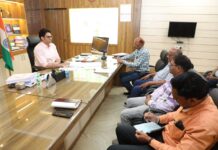- Mona goes to sleep at 9.30 pm and gets up at 5.30 am. How many hours does she sleep?
- If 3 tablets are needed to purify 15 litres of water, how many tablets would be needed to purify 50 litres of water?
- If the price of a T-shirt is Rs 300 and it is being sold at 10 per cent discount, how much will you have to spend to buy it?
Simple questions. Right? But you will be surprised to know that only 31.2 per cent students of age-group 14-16 years studying in schools in rural areas of Madhya Pradesh could tell that the girl slept for 8 hours and only 37.6 per cent could discover that 10 tablets would suffice. As for the T-shirt, just 10.9 per cent could say that they will have to shell out Rs 320 to buy it.
And the situation was the same down the line.
Only 17.7 per cent of class five students could subtract 57 from 74 and only 19.8 per cent could divide 865 by 7. And a staggering 48.6 per cent class one students could not recognise numbers from 1 to 9. Shockingly, even among class 8 students, 1.3 per cent could not recognise numbers 1-9 and only 41.4 per cent could recognise the numbers from 1 to 99. Around one-fifth (20.8 per cent) of the class 8 students could not subtract and 36.6 per cent could not divide.
These are among the conclusions of the Annual State of Education Report (ASER) 2018, published on January 15 this year. ASER is based on nation-wide household survey that provides a snapshot of children’s schooling and learning. This is the thirteenth ASER report.
According to the report, only not even half of the class five students can read standard one level text in Hindi. It goes like this ‘Har ravivar nani ghar aati hai. Hamare liye mithayee latee hai. Main Nani ke saath sota hoon. Wah mujhe kahani sunatee hai’.
The report also underlines the fact that students drop out from school at every stage and that among the drop outs, girls far outnumber boys. Thus, while only 4.2 per cent of children 6-14 years of age were not enrolled in schools, the figure was 23.4 per cent for the age-group 15-16 years. And the percentage of out-of-school girls was 26.8 per cent and of boys, 20.2 per cent.
As for the facilities available in the schools, while percentage of schools with kitchen shed for cooking mid-day meal went up from 89.9 per cent in 2010 to 85.7 per cent in 2018, the number of schools with no toilet facility dropped from 20 per cent to 5.2 per cent in the same period. However, only 68 per cent schools had useable toilets. Around 18 per cent schools did not have separate toilets for girls and around 60 per cent did not have electricity connection. In 96.2 per cent schools, no computer was available for the children to use and 16 per cent did not have a library.
Due to lack of teachers, the students of different classes are taught together in most of the rural schools in the state. In 85 per cent of the schools, students of standard two were found sitting with one or more other classes and in 78.4 per cent schools, standard four students were being forced to sit with students from other classes. Around 30 per cent schools did not have a playground and 57.4 per cent did not have any sports equipment.
While 97.8 per cent schools had School Management Committees but only 12.5 per cent had met in the last three months.






